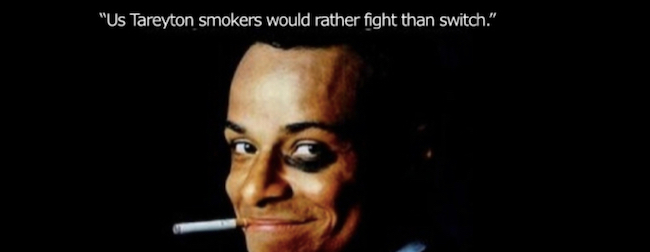
“Us Tareyton smokers would rather fight than switch” was a classic advertising slogan of the Don Draper era. Featuring a smiling model with a black eye, the grammatically incorrect Tareyton print ads ran from 1963 until the early 1980s. (Cigarette advertising on TV ended in 1971.) On its surface, the slogan was a clever way to encourage loyalty to the Tareyton brand. Yet beneath the surface, it was an insidious and not-so-subtle rallying cry for smokers to ignore the evidence linking smoking to cancer that started mounting in earnest with the 1964 Surgeon General’s report.
In the 55 years since the report was issued, the percentage of Americans who smoke has fallen from 42% in 1964 to 14% today. But nearly 34 million Americans still smoke, apparently willing to fight to the death than switch.
Why is it so hard to convince someone to believe scientific evidence if that evidence contradicts what they currently believe? Why won’t scientific evidence convince someone to stop smoking, give their baby a life-saving vaccination, or stop texting while driving?
Social scientists are only now beginning to comprehend why people refuse to believe the evidence that challenges their existing beliefs. “In 2006, political scientists Brendan Nyhan and Jason Reifler identified a phenomenon they called the ‘backfire effect,’” according to an article in The New York Times.
“They showed that efforts to debunk inaccurate political information can leave people more convinced that false information is true than they would have been otherwise.”
They now have conducted similar research related to healthcare beliefs like childhood vaccination fears and have discovered the same type of backfire effect to scientific evidence that differs from people’s existing beliefs. “Giving people corrected information is often ineffective with the people whose minds we’d like to change, and in some cases it actually can make the problem worse,” Nyhan told NPR social science correspondent Shankar Vedantam in a 2014 interview. “It’s much harder to change people’s minds than we might have thought.”
While not fully understood, a leading theory on why people cling to long-held, yet incorrect, beliefs is that such beliefs contribute to our sense of who we are and can even be a factor in our self-esteem. So when someone presents us facts disproving what we believe, we may subconsciously fight back against the new information because it damages something about our identity.
If this is true—that patterns of belief inform our sense of who we are and influence self-esteem—marketers might want to rethink messages intended to convince potential customers that the marketer’s product is scientifically superior to the product the customer is now using. Our pitch, full of pride, may cause the customer to think, “Hey, are you saying I’m an idiot because I’ve always used the other guys’ widget? If so, get ready for a black eye.”<
How to lessen the backfire effect: Focus the narrative of your product on the aspirations of customers, not on comparisons that claim the technical features of your product are better than those of the competitor. Rather than accidentally triggering a customer’s subconscious need to defend what they currently believe, look for ways to ease their journey across a bridge to a new reality they can discover for themselves. Help them find their way to the truth, step-by-step, instead of bashing them over the head with it. Persuading customers to switch is so much easier if you can avoid the fight.
Note: A version of this Idea originally ran on March 20, 2014. It has since been updated.
About Hammock Idea Emails | This post is part of Hammock’s award-winning Idea Email series. Idea Emails come in two flavors: Original and Healthcare. To subscribe to the original Idea Email (general marketing ideas), click here. To subscribe to the Healthcare Idea Email (healthcare marketing ideas), click here.

